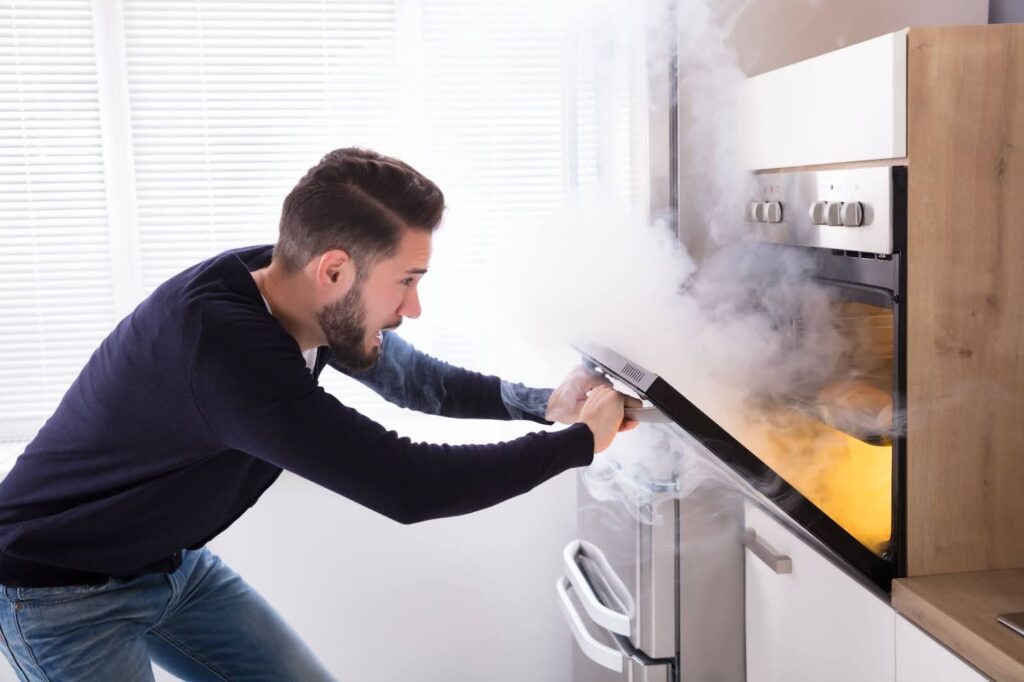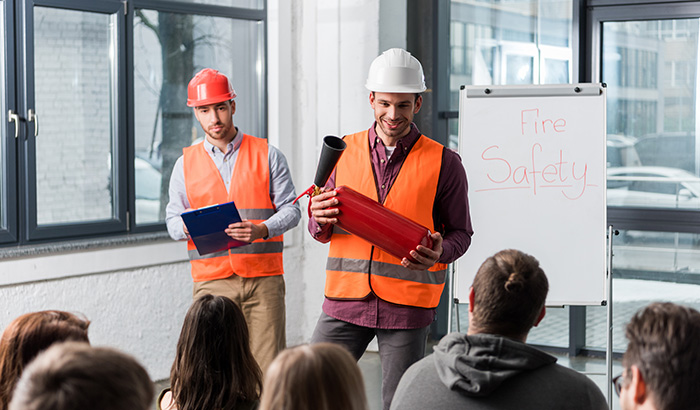Home fire safety is an aspect of everyday living that you should never overlook. Each year, residential fires cause significant property damage and pose serious risks to personal safety.
Prevention and preparedness are the key to protecting your home and loved ones from the dangers of fire. When homeowners understand and implement essential fire safety measures, they significantly reduce the risk of fire.
This blog will explore a range of fire safety tips designed specifically for homeowners. From installing smoke alarms to planning escape routes, these tips will provide you with the knowledge and tools needed to create a safer living environment and avoid fire damage.
1. Install and maintain smoke alarms
One of the most critical steps to ensure fire safety in your home is installing and regularly maintaining smoke alarms. By installing and maintaining smoke alarms properly, you significantly increase your home’s fire safety. These simple yet effective devices are your first line of defense against the dangers of fire, providing the early warning necessary to protect your home and loved ones.
Installation
Install smoke alarms on every level of your home, including the basement and near all sleeping areas. For added protection, consider installing smoke alarms inside each bedroom. Place the alarms on the ceiling or high on the wall to detect rising smoke.
Testing and maintenance
Test your smoke alarms at least once a month by pressing the test button. Replace the batteries at least once a year or as soon as you hear the low-battery warning, which is usually a chirping sound. You should replace smoke alarms every ten years as their sensors tend to degrade over time.
Interconnected smoke alarms
Consider using interconnected smoke alarms, which, when one sounds, all sound. This setup ensures that no matter where a fire starts, you will hear the alarm immediately, even if you’re in a different part of the house.
2. Plan and practice a fire escape plan
A well-thought-out fire escape plan is a crucial element of home fire safety. It ensures that in the event of a fire, every member of your household knows exactly what to do and where to go, increasing the chances of a safe evacuation.
Creating your plan
Start by identifying two ways out of every room, preferably a door and a window. Ensure that all escape routes are clear of obstructions and that you can easily open all your windows. For homes with multiple floors, consider investing in escape ladders for upper-level rooms.
Designate a meeting place
Choose a safe, easily accessible meeting place outside your home, such as a neighbor’s house, a streetlight, or a mailbox. This is where everyone will gather after escaping, allowing you to quickly account for all household members.
Practice makes perfect
Regularly practice your fire escape plan with all members of your household, including children and elderly family members. Conduct drills at least twice a year, both during the day and at night. Practice using different escape routes and ensure everyone knows how to call 911 or your local emergency number once they are safely outside.
Remember, in a fire, every second counts. A well-practiced fire escape plan can make the difference between safety and tragedy. Ensure that everyone in your home is familiar with and comfortable executing the plan so you’re all prepared in case of a fire emergency.

3. Employ safe cooking practices
The kitchen is one of the most common places where home fires start, but you can prevent fires by following safe cooking practices. Being mindful while cooking and taking simple precautions reduces the risk of fires.
Never leave cooking unattended
Always stay in the kitchen while you are frying, grilling, boiling, or broiling food. If you must leave the kitchen for even a short period, turn off the stove. Unattended cooking is a leading cause of kitchen fires.
Keep flammable items away from fire and heat sources
Keep anything flammable — oven mitts, wooden utensils, food packaging, towels, or curtains — away from your stovetop.
Be prepared to extinguish a fire
Keep a lid nearby when you’re cooking to smother small grease fires. Smother the fire by sliding the lid over the pan and turning off the stovetop. Leave the pan covered until it is completely cooled. For an oven fire, turn off the heat and keep the door closed.
Keep appliances clean
Regularly clean cooking surfaces to prevent grease buildup, which can ignite a fire.
Be cautious with cooking oil
Heat cooking oil slowly and watch it closely; it can ignite quickly.
Install a smoke alarm near the kitchen
While keeping it away from cooking fumes, install a smoke alarm near the kitchen to alert you of potential fires.
4. Practice heating safety
As temperatures drop, the use of heating equipment increases, bringing with it the need for heightened fire safety awareness. Heating equipment is one of the leading causes of home fire deaths, so following safety guidelines is crucial.
Maintain safe distances
Keep anything flammable at least three feet away from heating equipment, like a furnace, fireplace, wood stove, or portable space heater. This safe distance helps prevent flammable items from catching fire.
Use heating equipment properly
Always use heating equipment according to the manufacturer’s instructions. Never use your oven to heat your home, and use only the right kind of fuel specified for fuel-burning space heaters.
Inspect and maintain heating equipment
Have a professional clean and inspect heating equipment and chimneys every year. This ensures they function properly and helps prevent fires and avoid potential fire hazards.
Fireplace safety
If you use a fireplace, ensure it has a sturdy screen to stop sparks from flying into the room. Make sure the ashes are cool before putting them in a metal container, and keep the container a safe distance from your home.
Space heater safety
When using space heaters, place them on a hard, level, and nonflammable surface. Never plug them into an extension cord or power strip, as this may cause overheating and potentially start a fire.
5. Practice electrical safety
Electrical fires are a significant risk in many homes, but you can usually prevent fires with proper safety practices and regular maintenance. Understanding and adhering to electrical safety guidelines is crucial to reducing fire risk.
Proper use of extension cords and outlets
Avoid overloading electrical outlets and extension cords, as this sometimes leads to overheating and potential fires. You should only use extension cords temporarily; they are not a permanent solution. Ensure that cords are not running under carpets or across doorways where they might get damaged.
Regular inspection of electrical systems
Have a qualified electrician inspect your home’s electrical system every few years to ensure it is safe and up to code. This inspection includes checking for loose-fitting outlets, outdated wiring, and faulty electrical panels.
Safe appliance use
Always follow the manufacturer’s instructions for all electrical appliances. Unplug small appliances when not in use to reduce the risk of electrical fire.
Be mindful of warning signs
Pay attention to warning signs of electrical problems, such as frequent circuit breaker trips, flickering lights, or a burning smell from appliances or outlets. If you notice any of these signs, contact a professional electrician immediately.

6. Practice candle and smoking safety
Candles and smoking materials are common sources of home fires, but you can minimize these risks with proper precautions.
Candle safety
Always place candles on a sturdy, heat-resistant surface away from anything flammable, including curtains, bedding, and furniture. Keep candles out of reach of children and pets to prevent accidental tipping. Never leave candles burning unattended, and always extinguish them before going to bed or leaving the room. Consider using flameless candles, which provide the same ambiance without the fire risk.
Smoking safety
If you smoke, do so outside the home to reduce fire risk. Use deep, sturdy ashtrays and completely extinguish cigarette butts and ashes before disposing of them. Never smoke in bed or when you are drowsy, as this increases the risk of a fire. Keep lighters and matches out of reach of children.
Properly extinguishing smoking materials
Wet cigarette butts and ashes before throwing them away to ensure they are fully extinguished. Never discard butts or ashes in potted plants, trash cans, or other areas where they have the chance to smolder and ignite.
7. Store flammable materials safely
Proper storage of flammable materials and chemicals is essential in maintaining fire safety in your home. Many household items — such as cleaning agents or aerosol cans — are highly flammable and require careful handling and storage.
Designate a safe storage area
Store flammable materials in a cool, dry place away from living areas. Ideally, use a well-ventilated area like a detached shed or garage. Ensure that this area is out of reach of children and pets.
Keep away from heat sources
Never store flammable materials near heat sources such as furnaces, stoves, or heaters. Even a small amount of heat could trigger a fire with certain materials.
Use proper containers
Store flammable liquids in appropriate containers with tight-fitting lids to prevent vapors from escaping. Never use food or beverage containers for storage to avoid accidental ingestion.
Follow the manufacturer’s instructions
Always read and follow the manufacturer’s instructions for storing and disposing of flammable materials. This ensures that you are handling these materials safely and responsibly.
When fire strikes, call Utah Disaster Clean Up & Restoration
Adhering to fire safety tips is crucial for safeguarding your home against fire risks. As a homeowner, your active involvement in implementing these safety measures plays a vital role in protecting your property and loved ones. Remember, prevention is always better than cure, especially when it comes to fire hazards.
If you need assistance recovering from a fire, don’t hesitate to contact Utah Disaster Clean Up & Restoration. Our team of experts is ready to provide you with comprehensive support and guidance to restore your home after a fire, flood, or storm. When your home is damaged, call on us; we’ll get you back to the home you love.



